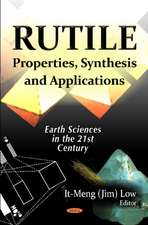A Key for Identification of Rock-Forming Minerals in Thin Section
Autor Andrew J. Barkeren Limba Engleză Paperback – 21 noi 2014
Commencing with a brief introduction to mineral systems, and the properties of minerals in plane-polarised and cross-polarised light, the mineral key also includes line drawings, tables of mineral properties and an interference colour chart, to further aid mineral identification. To minimise the chance of misidentification, and enable less experienced petrologists to use the key with confidence, the key has been arranged to prioritise those properties that are most easily recognised.
Designed for simplicity and ease of use, it is primarily aimed at undergraduate and postgraduate students of mineralogy and petrology, but should also provide a valuable source of reference for all practising geologists dealing with rock thin sections and their interpretation.
Preț: 295.77 lei
Nou
Puncte Express: 444
Preț estimativ în valută:
56.61€ • 58.34$ • 47.79£
56.61€ • 58.34$ • 47.79£
Carte disponibilă
Livrare economică 10-24 februarie
Livrare express 24-30 ianuarie pentru 30.63 lei
Preluare comenzi: 021 569.72.76
Specificații
ISBN-13: 9781138001145
ISBN-10: 1138001147
Pagini: 182
Ilustrații: illustrations
Dimensiuni: 174 x 246 x 13 mm
Greutate: 0.4 kg
Ediția:1
Editura: CRC Press
Colecția CRC Press
Locul publicării:Boca Raton, United States
ISBN-10: 1138001147
Pagini: 182
Ilustrații: illustrations
Dimensiuni: 174 x 246 x 13 mm
Greutate: 0.4 kg
Ediția:1
Editura: CRC Press
Colecția CRC Press
Locul publicării:Boca Raton, United States
Public țintă
UndergraduateCuprins
Introduction
Properties of Minerals in Plane-Polarised and Cross-Polarised Light
Symbols and Abbreviations
Minerals with 2 (or 3) Cleavage Traces
Minerals with 1 Cleavage Trace and Inclined Extinction
Minerals with 1 Cleavage Trace and Straight Extinction (Colourless)
Minerals with 1 Cleavage Trace and Straight Extinction (Coloured)
Minerals with Imperfect Cleavage, Parting of Arranged Fractures
Minerals with 0 Cleavage Traces (Colourless)
Minerals with 0 Cleavage Traces (Coloured)
Common Opaque Minerals
Table of Interference Colours and Corresponding Birefringence Values
Glossary
Index of Minerals (Cross-Referencing to Table Number(s) and Page(s))
Colour Chart
Properties of Minerals in Plane-Polarised and Cross-Polarised Light
Symbols and Abbreviations
Minerals with 2 (or 3) Cleavage Traces
Minerals with 1 Cleavage Trace and Inclined Extinction
Minerals with 1 Cleavage Trace and Straight Extinction (Colourless)
Minerals with 1 Cleavage Trace and Straight Extinction (Coloured)
Minerals with Imperfect Cleavage, Parting of Arranged Fractures
Minerals with 0 Cleavage Traces (Colourless)
Minerals with 0 Cleavage Traces (Coloured)
Common Opaque Minerals
Table of Interference Colours and Corresponding Birefringence Values
Glossary
Index of Minerals (Cross-Referencing to Table Number(s) and Page(s))
Colour Chart
Notă biografică
Dr Andrew Barker has taught mineralogy and petrology at the University of Southampton for more than 30 years. He has research interests in metamorphic petrology, rock microstructures, fluid infiltration and mineralisation. As well as publishing research papers over three decades, he has also authored a textbook on metamorphic textures and microstructures, and has supervised PhD projects in Europe, Africa and Australia. His initial research concentrated on deformationmetamorphism inter-relationships during Caledonian and Hercynian orogenesis in Europe, but subsequently moved to look at mineralised Precambrian terrains in Africa. After a period of sabbatical leave to Australia in the late 1990s, his most recent research has concentrated on fl uid infiltration processes, reaction mechanisms and mineralisation.
Descriere
The key for identification of rock-forming minerals provides an efficient and systematic approach to identifying minerals in thin-section. It is structured in the form of a dichotomous key, comparable to those widely used in botany and entomology. Whilst some previous mineralogy and petrology texts have produced tabulated summaries of minerals with similar properties, the present key gives a unique solution for each mineral.
The key covers more than 150 of the most commonly encountered rock-forming minerals, plus a few rarer but noteworthy minerals, indicative of particular conditions. Illustrated in full colour, with high quality photomicrographs of each mineral, it also provides the most comprehensive atlas of rock-forming minerals currently available. It is primarily aimed at undergraduate and postgraduate students of mineralogy and petrology, but should also provide a valuable source of reference for all practising geologists dealing with rock thin-sections and their interpretation.
Although including a brief introduction to the properties of minerals in this-section, the key largely assumes that the user has a basic understanding of optical mineralogy and is able to determine basic mineral properties in thin-section using plane-polarised and cross-polarised light. The key has been designed in such a way as to prioritise those properties that are most easily defined, and thus less ambiguous. This aims to minimise the chance of misidentification and enable the less experienced petrologist to use the key with confidence. The key has been carefully designed to enable different cuts of minerals (e.g. end-section and side sections) to be recognised and keyed out.
The key covers more than 150 of the most commonly encountered rock-forming minerals, plus a few rarer but noteworthy minerals, indicative of particular conditions. Illustrated in full colour, with high quality photomicrographs of each mineral, it also provides the most comprehensive atlas of rock-forming minerals currently available. It is primarily aimed at undergraduate and postgraduate students of mineralogy and petrology, but should also provide a valuable source of reference for all practising geologists dealing with rock thin-sections and their interpretation.
Although including a brief introduction to the properties of minerals in this-section, the key largely assumes that the user has a basic understanding of optical mineralogy and is able to determine basic mineral properties in thin-section using plane-polarised and cross-polarised light. The key has been designed in such a way as to prioritise those properties that are most easily defined, and thus less ambiguous. This aims to minimise the chance of misidentification and enable the less experienced petrologist to use the key with confidence. The key has been carefully designed to enable different cuts of minerals (e.g. end-section and side sections) to be recognised and keyed out.








